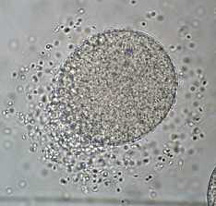|
The sea urchin egg is 10,000 times
bigger than the sperm (Fig. 7.4). It is covered with the
jelly coatand the
vitelline "membrane", a protein "shell" just
outside the plasma membrane.
The vitelline
membranecontains proteins
that bind to sperm of the same
species.

Because
the egg must supply all of the needs of the embryo until it
has developed a mouth and digestive system, it is jammed
full of yolkgranules,
mitochondria, metabolic
precursors, endoplasmic reticulum and protein synthetic
machinery. In addition to the nucleus, the sea urchin egg
also contains 25-50,000 maternal
mRNAspecies that control
early development.
Finally,
the egg contains a set of secretory vesicles, the
cortical granules,
lined up just inside the plasma membrane (Fig.
7.6).
When a
sperm cell encounters an egg of the same species, components
of the jelly coat bind to specific "egg receptors" in
the plasma membrane ( Fig. 7.8).
This triggers a signal
transduction
cascaderesulting in a
series of events that facilitate fertilization.
First,
an influx of
calciuminduces the fusion
of the plasma membrane with the membrane surrounding the
acrosome, releasing a set of hydrolytic enzymes
which digest a channel in
the jelly coat. This also results in the replacement of the
plasma membrane over the front of the sperm by what had
previously been the inside of the acrosome vesicle membrane.
This exposes a new "egg receptor" to the environment (Fig.
7.10, 7.15).
Actin
filaments form at the tip of the sperm head extending the
acrosomal process, a
long proboscis that penetrates through the jelly to contact
the vitelline membrane of the
egg. The tip of the acrosomal process binds to the
egg plasma membrane (Figure
7.19).
The egg
also has specific "sperm receptors" which extend
through both the plasma
membrane of the egg and the vitelline membrane. They bind to
newly exposed surface proteins that had previously been
inside the acrosome. This selects for sperm that have
undergone the acrosome reaction. Therefore, the two
binding events have to occur
sequentiallyand help to
ensure species-specificity.
The
binding of sperm to the receptor triggers a second signal
transduction cascade resulting in 1) the opening of Na+
channelscausing a
transient depolarization; 2) a
wave of "free" Ca++and
3) a rise in intracellular pH.
|
